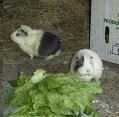|
 Home Home
 What's New? What's New?
 Definition Definition
 Our Design Our Design
 Techniques Techniques
 Articles Articles
 Blog Blog
 About Us About Us
 Year Planner Year Planner
 Resources Resources
 Links Links

Like us on
FaceBook!

Link to this site
|
|
Permaculture Techniques - Useful Animals in a Permaculture System
Factors that affect successful integration of animals
Any of the following factors can affect the survival or success of any animal species in a permaculture environment. Indigenous mammals, birds, insects, reptiles and amphibians are necessary for the sustained success of a permaculture system. These creatures help to build the health of the environment. Some of the factors are general and apply to most of the species found in a permaculture environment, and some, like the disasters listed are unavoidable although their impact can be lessened through careful planning and design. Many of the other factors relate to common sense and good animal husbandry.
There are thousands of sources of information about all types of animals that can be incorporated into a permaculture system, and specific references should be accessed to ensure optimum conditions for success are met. The aim of the permaculturalist is to ensure natural succession, with an emphasis on self-forage or free ranging where possible.
Climatic
- temperature: protection from extremes, correct temperature at different stages of growth (young, eggs, nursing, hatching ...)
- wind: protection from strong, hot, dry winds against dehydration and exhaustion; or cold, wet winds against chills
- rainfall: some animal species require adequate shelter from rainfall for optimum health (eg chickens), all require shelter from severe storms and hail; some animals require shelter at certain times, eg lambing.
- shelter: against wind, sun, rain, temperature extremes, fire. Dependant on species, can be natural or purposefully constructed (planted shelter belts, sheds, barns, etc.)
- shade: from summer sun, UV radiation - humidity: can affect some animals ability to cool themselves, also high humidity can promote parasitic infection and diseases (especially fungal)
Food Supply
- access to quality feed: preferably organic in origin, or grown on site
- nutrients: vitamins, mineral supplements - direct or through improved pasture (ground rock supplements, organic practices)
- sufficient quantity of food: according to specific requirements of species, preferably available through free range practice
- water: adequate supply, clean, fresh, for consumption, habitat as necessary by individual species or breed
- attention to specific species food requirements; flowers for butterflies, bees; insect larvae, etc for crustaceans, fish, frogs; seeds, fruit, small mammals and reptiles for birds; compost for worms (the permaculture garden through organic practice and attention to diversity and relative location generally ensures an abundance of food via a healthy food chain.)
- unpolluted food: clean, free from contamination (animal excrement, residues of biocides, supplements such as growth hormones, antibiotics, etc)
- Disasters: flood,,fire,,prolonged drought, disease (avoided by good quarantine practice where possible),,severe storms (cyclone).
Human Attention
- structures according to species (chook house, milking shed, food storage shelters, eg hay barn, ponds or dams, bee hives, compost bins, barns, nesting boxes, etc)
- enclosures: suitable fences according to species (goats, pigs, sheep, cattle, emu, alpaca, rabbit, guinea pig, chicken, geese, duck, deer, etc - all have their own needs to not only keep them in the enclosure but also to keep predators out.)
- veterinary care: prevention of disease, food supplements, treatment of injury and parasite infestation, assistance with difficult reproduction
- control of feral animals (especially cats and dogs for predation, rabbits and goats competition for food and degradation of environment)
- population control, especially in respect to resource management
- suitable provision for transportation (which does not injure species)
- adherence to legal practice (eg rabbit breeding, placement of hives) - in SA it is illegal to take honey or bees to Kangaroo Island, other areas may have restrictions which can affect the success of proposed animal farming.
- attention to quarantine when introducing new stock
- attention to suitability of species to area, not just for survival or success of animal, but avoidance of environmental disturbance if the species becomes wild (insects, rabbits, goats, fish, birds, koalas)
- hygiene in all farming practice - to avoid the spread of disease not only in animals but in humans too.
- selective breeding to encourage strong, healthy species; and selection of breed suited to particular site (eg dexter cattle for small acreages) or need (merino sheep for fine wool)
back to Animals
|
|

Our ever-changing view!
Moonset ~ Roll Cloud ~ Sunset
|
permaculture ethics |
care for earth,
care for people,
return surplus,
reduce consumption |
 |
|
Recently Added Pages
Hot Links!

Bookworm is currently reading...
This site is sponsored by
ALWAYS LEARNING BOOKS
Publishers of Australian
books on Home Education.
  The Educating Parent The Educating Parent
  Beverley's other websites Beverley's other websites
|





